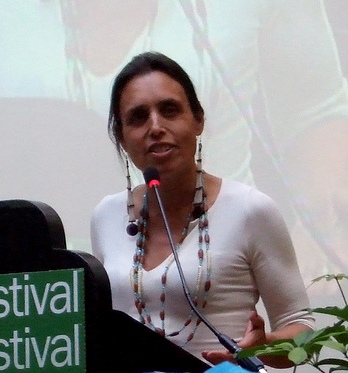
Winona LaDuke, photo credit Earthworm
Editor’s note: Winona LaDuke will speak at Seattle University on February 28th, 2013. Sightline can’t wait to hear her again! Tickets went on sale today, January 16th, at noon. Event details are on Facebook, and tickets are available through Brown Paper Tickets. Below is Sightline’s mid-2006 interview of LaDuke.
Winona LaDuke was Ralph Nader’s running mate on the 2000 Green Party ticket and is a longtime leader on tribal environmental issues. In the six years since she left the limelight of Presidential politics, LaDuke has been campaigning for renewable energy, especially on tribal reservations. A member of the White Earth Reservation in northwestern Minnesota, LaDuke says tribes have reaped few benefits from energy extraction and suffered a disproportionate share of the environmental fallout from mining, drilling, nuclear waste disposal, and emissions from coal burning. She believes that the combined wind power of the gustiest reservations, such as Rosebud and Pine Ridge in the Great Plains, could meet more than half of current US demand for electricity.
So far, LaDuke has succeeded in convincing her own reservation to erect a wind turbine, and has helped promote wind power on the Rosebud, Pine Ridge, and Blackfeet reservations and solar power for the Hopi and Navajos. Never afraid to get her hands dirty, LaDuke has been plotting out her own community’s energy plan while staying active in the lives of her three children and planning the arrival of a new grandchild. She has also continued to protest nuclear power and fight against the genetic engineering of wild rice.
Raised in Ashland, Oregon, LaDuke still holds ties to the Pacific Northwest. I caught up with her late in the evening via cell phone as she drove from Eugene to Ashland in her biodiesel Mercedes, her family in tow. Following are excerpts from our conversation:
Sightline: You’ve been an activist for about 25 years now, and you’ve worked on a huge range of issues. Why renewable energy?
WLD: I work in my own community, and I’m a rural development economist. In my reservation, the main thing I work on is how you build a self-reliant, culturally revitalized community that’s going to survive in the post-petroleum economy. I work with the White Earth Land Recovery Project, which is a pretty large Native organization, on food sovereignty issues. And I’ve worked on energy issues most of my adult life. I debated the topic in high school, when the national debate topic was on energy policy, and I’ve worked on it ever since. I’ve spent a good portion of my life fighting bad projects: coal mines, uranium mines, gas pipelines, dams. And the reality is that in the largest energy economy in the world, you’ve got to transform the economy to a renewable economy.
Sightline: What energy campaigns are you working on now?
WLD: Well, on my own reservation we are working on an energy plan. It basically says my reservation needs eight megawatts of electricity to power it. We could get that out of wind pretty easy because we’re the windiest reservation in the state of Minnesota. And then I said we should look at biofuels for our fuel sources. So actually, I’m driving my biodiesel-and-grease Mercedes right now. And I want to do that to the fleet of tribal vehicles on the reservation.
Sightline: When you say grease, do you mean recycled vegetable oil?
WLD: Yeah. It’s not all recycled though. At a certain point in the fuel chain, they’re just putting regular soybean and canola oil in, too. My tribal casino produces 10,000 gallons of grease a year [from food vendor operations], so my eye is on that grease. But that will only fuel half of a school bus. So you’ve got to mix it in with a whole production system.
Sightline: What reaction have gotten from Native communities on the issue of renewables?
WLD: A lot of interest. I talked to my tribe, and I said, look, world petroleum supplies just peaked. Basically, we better come up with a plan. There’s also interest nationally. I had a couple of tribes sign onto Kyoto. My tribe’s going to sign onto Kyoto. But I’m interested in Northwest tribes considering what their renewable energy plan would be.
Sightline: What role do you think tribes should play in this country’s energy economy?
WLD: Tribes have the potential to produce half of present installed electrical consumption. Indian reservations are the windiest places in the country. The Northwest is a little different. But eastern Washington, you’ve got some pretty windy reservations out there. In eastern Oregon, Umatilla’s pretty windy. But you go east of there, and everything is windy over to our reservation, as is the northern Great Lakes.
Sightline: What are the most promising clean energy developments you’ve seen recently?
WLD: I’ve seen the example of my own community. We put up solar heating panels and one wind turbine. We’re going to put up a few more. I saw Rosebud reservation put up a first commercial wind turbine.
Sightline: What would you suggest to someone who wants to get more involved in energy issues?
WLD: Work on ordinances. Work on trying to get small power up and big power up. Work on energy efficiency. There’s plenty to work on. And also figure out how to work with these indigenous communities.
Sightline: Do you have thoughts of running for political office again?
WLD: My work is outside of the electoral arena. I ran twice. I might run in Minnesota. I might run for governor. I might run for one of those [state-level] seats one of these days. But right now, I’m plenty busy. I can get more work done just the way I do it.






